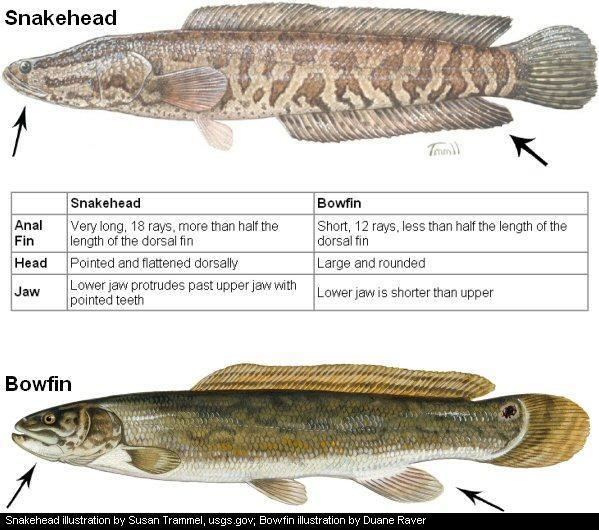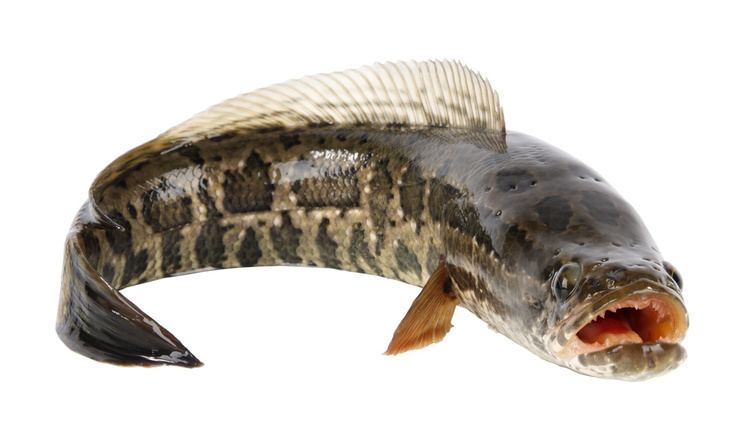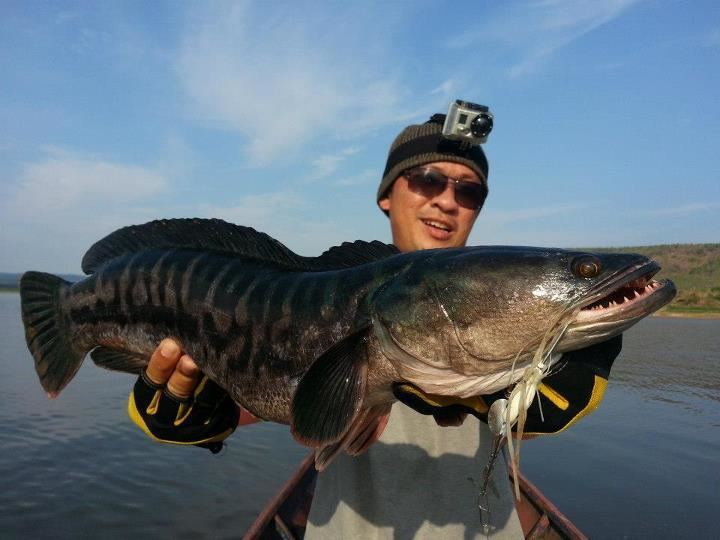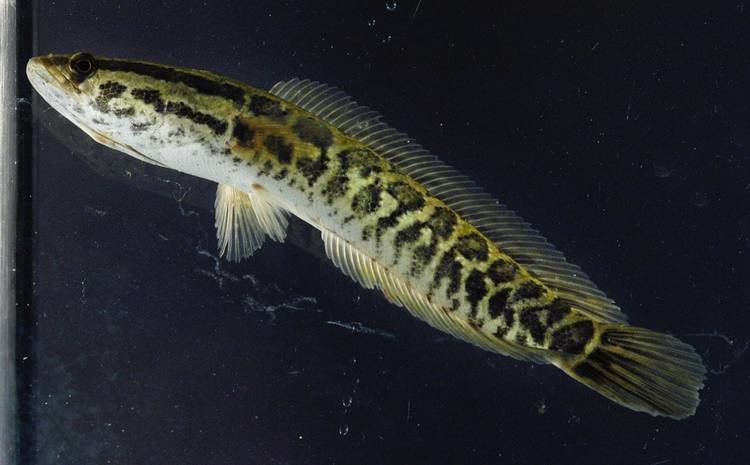Suborder Channoidei Higher classification Channoidei Phylum Chordata | Subphylum Vertebrata Scientific name Channidae Rank Family Order Perciformes | |
 | ||
Lower classifications Snakehead murrel, Giant snakehead, Channa, Northern snakehead, Blotched snakehead Similar Amur catfish, Catfish, Bass, Tilapia, Alligator gar | ||
The snakeheads are members of the freshwater perciform fish family Channidae, native to parts of Africa and Asia. These elongated, predatory fish are distinguished by their long dorsal fins, large mouths, and shiny teeth. They breathe air with gills, which allows them to migrate short distances over land. They have suprabranchial organs developing when they grow older, which is a primitive form of a labyrinth organ. The two extant genera are Channa in Asia and Parachanna in Africa, consisting of about 35 species.
Contents
- Description
- History
- Ecological concerns
- Intentional introductions
- In the United States
- Elsewhere
- As food
- Classification
- In popular culture
- References

They are valuable as a food source and have become notorious as an intentionally released invasive species.
Description

The various species of snakeheads differ greatly in size. Dwarf snakeheads, such as Channa gachua, do not surpass 25 cm (10 in) in length. Most other snakeheads reach between 30 and 90 cm (12 and 35 in). Five species (C. argus, C. barca, C. marulius, C. micropeltes and C. striata) can reach 1 m (3 ft 3 in) or more.

Snakeheads are thrust-feeders that consume plankton, aquatic insects, and mollusks when small. As adults, they mostly feed on other fish (such as carp) or on frogs. In rare cases, small mammals such as rats are eaten.
History

The Channidae are well represented in the fossil record and known from numerous specimens. Research indicates snakeheads likely originated in the south Himalayan region of the Indian Subcontinent (modern-day northern India and eastern Pakistan) at least 50 million years ago (Mya), during the Early Eocene epoch. Two of the earliest known species, Eochanna chorlakkiensis Roe 1991 and Anchichanna kuldanensis Murray & Thewissen, 2008, have both been found in the Middle Eocene of Pakistan. By 17 Mya, during the Early Miocene, Channidae had spread into western and central Eurasia, and by 8 Mya, during the late Tortonian, they could be found throughout Africa and East Asia. As Channidae are adapted to climates of high precipitation with mean temperatures of 20 °C (68 °F), their migrations into Europe and Asia correspond to the development of the Intertropical Convergence Zone, which increased air humidity, and the intensification of the East Asian monsoon, respectively. Both weather patterns emerged due to greater vertical growth of the Alps, Pyrenees, and Himalayas, which affected Eurasian climatic patterns.
Ecological concerns
Snakeheads can become invasive species and cause ecological damage because in many areas to which they are not native the absence of natural enemies gives them top-level predator status. Not only can they breathe air, but they can also survive on land for up to four days, provided they are wet, and are known to migrate up to 400 metres (1/4 mile) on wet land to other bodies of water by wriggling with their body and fins. National Geographic has referred to snakeheads as "Fishzilla" and the National Geographic Channel reported the "northern snakehead reaches sexual maturity by age two or three. Each spawning-age female can release up to 15,000 eggs at once. Snakeheads can mate as often as five times a year. This means in just two years, a single female can release up to 150,000 eggs."
"Since 2002, it has been illegal to possess a live snakehead in many US states, where they are considered a destructive invasive species." Virginia has criminalized the "introduc[tion]" of snakeheads into the state without specific authorization, although the relevant statute does not explain whether mere importation is sufficient to constitute "introduc[tion] into the Commonwealth" or whether instead release into the environment is required.
Intentional introductions
Humans have been introducing snakeheads to nonindigenous waters for over 100 years. In parts of Asia and Africa, the snakehead is considered a valuable food fish, and is produced in aquacultures (fisheries motivation) or by ignorance (as was the case in Crofton, Maryland). Some examples of the introduction of snakeheads to nonindigenous waters include:
In the United States
Snakeheads became a national news topic in the United States because of the appearance of Channa argus, commonly known as northern snakeheads, spawning in a Crofton, Maryland, pond in 2002. Northern snakeheads became permanently established in the Potomac River around 2004, and possibly established in Florida. Apparently, unestablished specimens have been found in Wawayanda, New York, two ponds in Philadelphia, Pennsylvania, and reservoirs in North Carolina.
The northern snakehead in the Potomac River system, has an estimated population of over 21,000 in over 120 miles of river(200 kilometers).
One Los Angeles supermarket was found to have illegally sold $25,000 worth of live snakeheads from 2002 to 2003, which caused breakouts in local ecosystems.
In what was determined by the Army Corps of Engineers to be an isolated incident, a fisherman caught a single snakehead on October 2004 while fishing from Lake Michigan at Burnham Harbor in Chicago, Illinois. According to the United States Environmental Protection Agency, snakeheads have also been spotted in California, Florida, Hawaii, Maine, Maryland, Massachusetts, and Rhode Island.
On April 25, 2011, a northern snakehead was found above Great Falls, Virginia near Whites Ferry. Great Falls was supposedly a natural barrier that the fish had been unable to cross. It is apparently the first time a northern snakehead was found above the falls.
"In May 2011, a Brooklyn fish importer was arrested for importing 350 live snakeheads into New York. He had tried to pass the fish off as Chinese black sleepers (Bostrychus sinensis) in an effort to mislead customs. He also admitted to importing six more shipments in 2010." It is unknown if any of the fish had been released into local waterways.
On March 28, 2012, Don Cosden, from Maryland's Department of Natural Resources confirmed that they were offering prizes for catching and killing any snakehead fish. To enter the contest, anglers had to catch, kill, and then post on the DNR's website a picture of themselves with a dead snakehead caught in Maryland.
The Bullseye Snakehead (Channa marulius) has become a major problem throughout South Florida waterways. It is an invasive threat to many of the native species. The largest one to be documented weighed 14 pounds, 3 ounces.
World record
According to the International Game Fish Association, Caleb Newton, a Spotsylvania County, Virginia resident, caught a world record 17 pound, 6 ounce northern snakehead at the junction of Aquia Creek and the Potomac River on June 1, 2013. The previous record, two ounces smaller, had been caught in 2004 in Miki, Kagawa, Japan.
Elsewhere
A report from Lincolnshire in the United Kingdom turned out to be a hoax.
A reported catch from the Welland Canal in Canada turned out to be a misidentified specimen of Amia calva, the primitive North American bowfin.
A snakehead in Central Park lagoon in Burnaby, British Columbia, was caught by city officials on June 8, 2012 after the lagoon was partially drained.
As food
Snakeheads are considered valuable food fish. Called nga yant in Burmese, it is a prized fish eaten in a variety of ways. In Vietnam, they are called ca loc, ca qua, or ca chuoi; it is prized in clay pot dishes and pickled preparations. Larger species, such as Channa striata, Channa maculata, and Parachanna obscura, are farmed in aquaculture. In the United States, chefs have suggested controlling the snakehead invasion by serving them in restaurants. In Indonesia, snakehead fish are called ikan gabus, served as the main parts of traditional dishes such as Betawi's pucung gabus, and considered to be a delicacy due to their rarity in wild and aquaculture, as they are harder to raise than other popular freshwater fish such as catfish and carp.
Classification
The snakeheads comprise two extant genera:
Two other genera are only known from fossils:
In popular culture
After its release in non-native North American waters, either accidentally or intentionally, the aggressive and predator-free snakehead's reputation as a "Frankenfish" or "monster fish" has become part of the culture Besides mentions on TV shows such as The Sopranos, the snakehead has been featured in three Sci-fi Channel original pictures entitled Snakehead Terror, Frankenfish, and Swarm of the Snakehead. In the Animal Planet TV series River Monsters, Jeremy Wade shows a dramatization of a snakehead, "the fish from hell", stalking an unsuspecting baby and Chihuahua. With the help of a snakehead researcher, however, Wade shows that although it is capable of living outside of water and is able to move on land, its weak pectoral muscles make movement difficult and render the snakehead an unlikely "stalker" on land.
